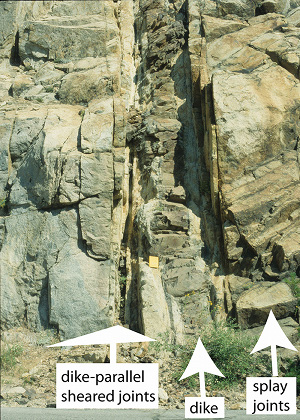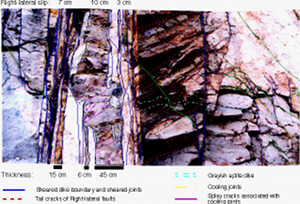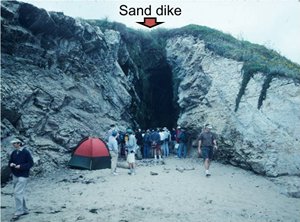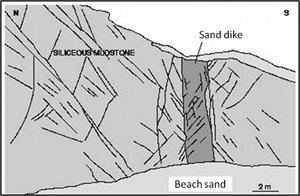| |||||||
|
|
|||||||
|
|
|||||||
| Faulting by Shearing of Dikes | |||||||
|
Dikes, similar to other planar or zonal weaknesses, localize shearing and initiate faulting. Figure 1 shows an example of this phenomena, where a magmatic dike of about 50 cm width and bounded by aplite dikes on both sides were all sheared. It is likely that some of the joints sub-parallel to the dike belong to the process zone associated with the formation of the dike, which were later sheared (Figure 2). Joints oblique to the dike are splays implying right lateral and right side-down shearing kinematics for the dike-parallel shearing. There are also dike-perpendicular joints localized within the dike material (Figure 2), which are likely of cooling origin. Interestingly enough, these joints were also sheared judging from the associated splays. An interesting combination of structures occurs from the deformation of sand dikes. The photograph in Figure 3 shows a 2 m wide sand dike which was intruded into a mudstone formation at Laguna Beach, north of Santa Cruz, California. As shown in the map in Figure 4, the boundary between the dike and the host rock, the host rock adjacent to the dike boundaries, and the sand within the dike have been faulted. Interestingly enough the mudstone has been crisscrossed by sharp faults and the dike sand has been deformed by shear bands.
Interested readers may compare and contrast the structures within and immediately outside of the magmatic dike and the sand dike including the modes and orientations of the associated structures, and their potential impact on fluid flow. | |||||||
| Reference: |
|||||||
| Aydin, A., Muller, J.R., Bergbauer, S., Du Bernard, X., Eichhubl, P., 2002 Eichhubl, P., Aydin, A., 1998 |
|||||||
|
Readme | About Us | Acknowledgement | How to Cite | Terms of Use | Ⓒ Rock Fracture Knowledgebase |
|||||||



